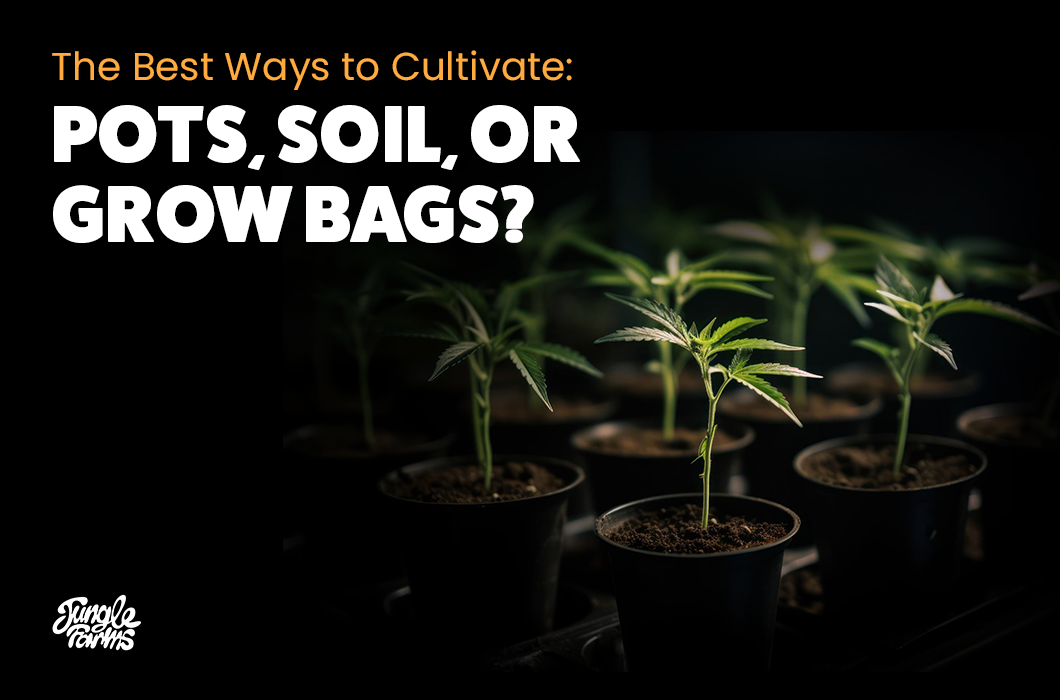The choice of whether to cultivate cannabis in pots, soil, or the increasingly popular grow bags is a decision of paramount importance. Each method has its unique set of advantages and challenges, adding fervor to the ongoing discourse on the most effective growing technique and the perfect medium.
While no method claims the definitive titles of “best” or “worst,” the ultimate choice hinges on individual factors—your specific growing conditions, personal preferences, and unique lifestyle. In this blog, we’ll explore the intricacies of pots, soils, and the trendy grow bags, unraveling their pros and cons to empower you in making a choice that aligns seamlessly with your cultivation aspirations.
Growing Cannabis in Pots: Pros and Cons
Pros: Control, Size Restriction, Mobility, and Pest Prevention
Growing cannabis in pots offers a wealth of advantages that cater to the meticulous gardener. The foremost among them is the unparalleled control over the soil and nutrition. By filling your pots with your chosen substrate, you eliminate concerns about the quality of your garden soil. The ability to choose the watering schedule and nutrient levels adds an extra layer of control. Should any issues arise, a simple move to a new pot with fresh soil can often remedy the situation.
Another perk is the restriction of plant size. The size of your cannabis plants is directly linked to the size of your containers. Larger pots result in taller, more robust plants, while smaller pots promote discreet growth. The mobility of pots is a further advantage, enabling easy relocation for optimal lighting or protection against the elements.
Pest prevention becomes more manageable in pots. Each plant residing in its own container reduces the likelihood of pests spreading to neighboring cultivars, facilitating early detection and treatment of infestations.
Cons: Maintenance, Watering Challenges, Limited Root Space, and Security Concerns
However, the very control pots provide can transform into a challenge. The increased control necessitates more maintenance and attention, demanding careful management of the plant’s environment. This can be a potential drawback for those new to cultivation or individuals with limited time and resources.
Watering challenges emerge as a con, with plants in pots relying on caretakers for their water supply. The risk of over or underwatering looms large, impacting oxygen intake and overall crop health. Poor drainage in pots often leads to the common mistake of overwatering.
Despite control over plant size, pots have a limitation on root space. Small containers can lead to root binding, where roots crowd and curl in search of water, restricting nutrient uptake and blocking airflow. While pots provide mobility, the flip side is the vulnerability to thieves, as potted plants can be easily transported by humans.
Growing Cannabis in Soil: Pros and Cons
Pros: Natural Environment, Less Maintenance, and Cost-Effective
Opting to grow cannabis in soil introduces a natural and forgiving environment. When sowing seeds or planting seedlings in open soil, plants easily derive organic matter and minerals from the ground. The roots, allowed to grow freely, often receive sufficient water from the groundwater alone. The healthy soil, rich in beneficial bacteria and nutrients, contributes to taller, stronger, and more productive plants.
Less maintenance becomes a notable advantage in soil cultivation. When plants find themselves in a favorable spot, minimal maintenance is required as roots expand freely, benefiting from natural microbes. Open soil proves popular for “guerilla grows,” tucked away in remote locations that are challenging to reach daily.
Cost-effectiveness adds to the appeal of soil cultivation. While pots incur costs for multiple transplants throughout a plant’s life, planting directly into the soil proves to be a more economical choice in the long run.
Cons: Less Control, Excess Growth, Non-Transportability, and Seasonal Limitations
Despite its merits, soil cultivation presents challenges. The trade-off for less maintenance is less control over the environment. Managing factors like soil type, pH, and nutrient levels becomes more challenging, making it harder to provide optimal growing conditions. Checking the quality and uniformity of the soil becomes essential, often leading growers to mix in additives for improved drainage and nutrient availability.
Excess growth is a concern in open soil, where roots have unrestricted space. While vigorous growth is generally positive, uncontrolled growth can be problematic, especially for those aiming to maintain a discreet garden. Training plants to encourage horizontal growth becomes crucial in controlling size.
Non-transportability is a limitation, as plants rooted directly in the ground cannot be moved. Exposure to weather and seasonal changes poses risks during storms or unfavorable growing conditions. Moreover, plants can only be grown at specific times of the year, unable to be brought indoors to control flowering or vegetative growth based on natural daylight.
Growing Cannabis in Grow Bags: Pros and Cons
Pros: Better Aeration, Overwatering Prevention, Temperature Control, and Eco-Friendly Options
Grow bags emerge as a popular alternative, offering unique benefits to cannabis cultivators. Excellent aeration is a standout feature, as the porous fabric material allows air to reach the root zone, preventing root binding. This “air pruning” process leads to healthier roots as the tips stop growing, prompting the plant to produce new, robust roots.
Overwatering prevention is another advantage of grow bags. Unlike pots, the fabric material allows any excess water to drain out, reducing the risk of root rot, mold, and fungus. Temperature control is also notable, as the breathable material prevents excess heat buildup, ensuring healthy airflow around the roots.
From an eco-friendly perspective, some grow bags are made from biodegradable plastics or natural materials like hemp. The option to plant grow bags directly in the ground adds to their sustainability, allowing them to decompose naturally over time.
Cons: Frequent Watering, Durability Concerns, Less Protection from Cold, and Aesthetics
Despite their advantages, grow bags present challenges. The need for more frequent watering is a significant consideration, as the well-aerated soil dries out faster than in pots. Close monitoring of humidity and regular watering become essential tasks.
Durability is a concern, as grow bags may not last as long as pots. Exposure to the elements or frequent movement can wear out the fabric over time, necessitating replacement every 2-3 growing seasons. While grow bags may be cheaper initially, the costs add up over time.
Less protection from cold is a drawback, as grow bags allow more air circulation. The soil inside grow bags cools down quickly on cold nights, posing risks during late spring or early fall frosts. Monitoring weather forecasts becomes crucial to avoid potential harm to plants.
Aesthetics play a role in the grow bag debate. Focusing on utility over looks, grow bags typically come in black, brown, or gray, lacking the visual appeal of traditional hard-sided pots. While aesthetics may not concern all growers, those growing in visible locations may have a preference for classic pots over fabric bags.
Final Thoughts: Tailoring Your Approach
For optimal cultivation methods, the choice between pots, soil, or grow bags evolves into a personalized journey, each presenting distinct advantages and challenges. Pots provide meticulous control, requiring diligent attention, while soil offers a natural environment with a compromise on control. Conversely, grow bags offer unique benefits but demand vigilant monitoring of watering frequency.
Ultimately, the decision lies firmly in the hands of the cultivator, who must carefully weigh the nuances of their specific circumstances, preferences, and lifestyle. Whether prioritizing control, minimal maintenance, or eco-friendly practices, the diverse range of options ensures a fitting choice for every aspiring cannabis gardener. As you navigate this season of growth, may your cultivation journey be as informed and dynamic as the plants you nurture.

